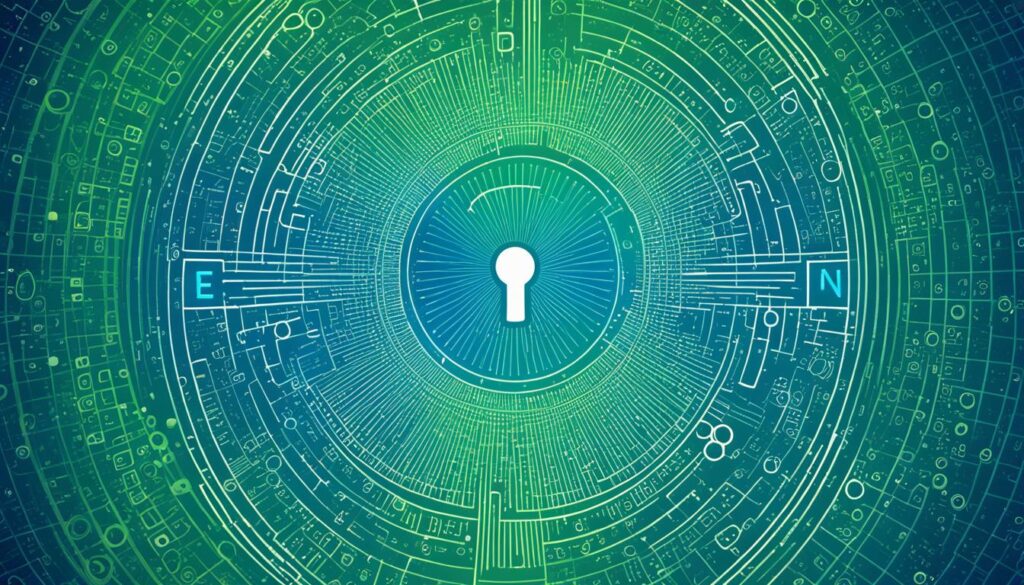Zoom leads the way in cybersecurity, adding post-quantum end-to-end encryption (E2EE) to its meetings. This quantum-resistant encryption enhances data security for users worldwide. Zoom’s initiative future-proofs user privacy and sets a new standard for secure communication. Their commitment to cybersecurity is clear, elevating them as a leader in the field.
The advent of quantum computing propels Zoom to revamp encryption, focusing on the future. They’ve chosen Kyber-768 to anchor their E2EE, benefiting Zoom Phone and Zoom Rooms. This advanced security measure parallels the strength of AES-192. It ensures Zoom meetings are safe, starting with version 6.0.10, where data breaches become a thing of the past.
Zoom Transitions to Cutting-Edge Encryption for Enhanced Security
Zoom has taken a significant step by adopting advanced encryption technologies, integrating Kyber-768 into its security lineup. The U.S. Department of Commerce’s National Institute of Standards and Technology (NIST) supports this move. It highlights Zoom’s dedication to protecting user data from emerging cyber threats. These threats are becoming more prevalent with the advancement of quantum computing.
The introduction of Kyber-768 elevates encryption standards to match those of AES-192. This is a monumental leap in the field of secure communication. As Zoom grows, these quantum-resistant cryptographic technologies boost user confidence. They also tackle the dynamic challenges of cybersecurity efficiently.
By adopting these forward-thinking technologies, Zoom isn’t just keeping pace; it’s setting the pace. It’s preparing for the vulnerabilities that future quantum computing might exploit. This approach reassures Zoom’s worldwide users, maintaining its status as a leader in secure online communication platforms.
Understanding Zoom’s Post-Quantum E2EE Algorithm Choice
The advent of quantum computing poses a significant threat to cybersecurity. Zoom, a leader in unified communications, has selected Kyber-768 for end-to-end encryption (E2EE). This quantum-resistant algorithm is a proactive step to protect user communications from future threats.
Kyber-768 is backed by the National Institute of Standards and Technology (NIST). It meets government encryption standards, providing AES-192 security levels. This signifies the strength of Zoom’s encryption approach, especially against complex quantum attacks.
Zoom incorporated this advanced security into its Meetings platform in 2020. It extended to the Zoom Phone service in 2022. By adopting Kyber-768, Zoom not only boosts user privacy but also leads in offering quantum-resistant video conferencing.
Zoom’s use of E2EE designed to fend off “harvest now, decrypt later” attacks is innovative. These attacks gather encrypted messages to decrypt them with future quantum computing. But, with E2EE, only meeting participants have the encryption keys. This ensures all shared information is secure and untouchable.
Choosing Kyber-768 reflects Zoom’s dedication to the forefront of technology. It also shows their cooperation with NIST to establish a secure, future-proof standard. Such security measures highlight Zoom’s commitment to protecting its users, offering assurance in the face of quantum threats.
As security becomes a top priority for users and businesses, Zoom’s integration of Kyber-768 marks a critical evolution in communication tech. It prepares for a future where advanced quantum computing could challenge current encryption. Zoom thus secures its users’ data against emerging threats in a post-quantum world.
Requirements for Enabling Zoom’s Advanced Encryption
To leverage Zoom’s advanced encryption fully, it’s critical to meet certain requirements. For privacy and security, users must upgrade the app to version 6.0.10 or greater. This specific update enables Zoom’s post-quantum end-to-end encryption (E2EE). It’s vital for protecting all communication participants from quantum computing threats.
Updating isn’t merely a procedural step; it’s essential for accessing superior security features. By integrating the Kyber-768 algorithm, Zoom Meetings’ data secures protection on par with AES-192. This advanced encryption defends against both traditional and potential quantum computing breaches, making it a formidable barrier against evolving threats.
Without the latest Zoom app version, users revert to standard E2EE, which, while secure, lacks quantum-resistant capabilities. This situation underscores the importance of continuous software updates for maintaining security integrity and functionality.
It’s crucial that all Zoom meeting participants meet these encryption standards. Effective data security and privacy require that everyone involved uses the updated application. Achieving uniform protection against quantum encryption breaches demands collective effort. Thus, Zoom champions a unified front in safeguarding digital communications against emerging threats.
Zoom Begins to Use Post-Quantum End-to-End Encryption
In a significant move, Zoom has implemented post-quantum end-to-end encryption (E2EE) on its Meetings platform. This pioneering step not only boosts security for users but lays the foundation for future extensions. These extensions will reach Zoom Phone and Zoom TV Rooms, ensuring wider coverage.

Zoom adopted Kyber-768, recognized by the NIST for its quantum-resistant properties. This ensures that decryption keys are exclusively held by meeting participants. It dramatically lowers the chance of unauthorized access to sensitive information. This shift towards post-quantum E2EE demonstrates Zoom’s dedication to protecting data privacy. It also shows its readiness to counter potential quantum computing threats.
Zoom’s strategic move to deploy post-quantum encryption mirrors a larger industry trend. Data privacy and secure communication are increasingly crucial. With plans to expand post-quantum E2EE to Zoom Phone and Zoom Rooms, Zoom is poised to lead in safeguarding digital communication. This move will protect against emerging cybersecurity risks.
The Threat of Quantum Computing to Current Encryption Methods
The rise of quantum computing poses a significant threat to traditional encryption methods. It challenges cryptanalysis, cybersecurity, and retrospective decryption. The core of today’s cybersecurity relies on encryption methods designed to protect privacy. Yet, the advanced capabilities of quantum computing could render these defenses ineffective.
Quantum computers use quantum mechanics to outperform classical computers. They solve complex mathematical problems, crucial to cryptographic systems, much faster. For example, Shor’s algorithm could break RSA encryption that secures emails and online transactions.
Grover’s algorithm poses a threat to AES-256, a standard for secure communication, by potentially cutting the time needed to break it. This raises concerns about future quantum computing decrypting data collected today.
In response, the cybersecurity community is exploring post-quantum cryptography. Methods like lattice-based cryptography and quantum key distribution are being developed. The National Institute of Standards and Technology (NIST) is crucial in endorsing quantum-resistant algorithms.
Organizations are moving towards quantum-resistant solutions. This shift involves revising cybersecurity frameworks. It requires collaboration among security teams, stakeholders, and technology providers to adopt strong encryption methods.
The potential impact of quantum computing on encryption and cybersecurity is significant. Businesses, especially in financial services and healthcare, need to evaluate their vulnerabilities. They must start taking steps to protect against future cryptographic challenges brought on by quantum advancements.
Zoom’s Proactive Measures Against Future Cyber Threats
Zoom is ahead in the game, embracing post-quantum cryptography to defend against future threats. As it expanded from 10 million to 300 million users, Zoom escalated its cybersecurity measures. It now includes cutting-edge encryption to thwart “harvest now, decrypt later” attacks. By using the Kyber 768 algorithm, Zoom fortifies its defenses, aligning with standards soon to be set by the National Institute of Standards and Technology (NIST).
The Linux Foundation is also on board, leading the Post-Quantum Cryptography Alliance (PQCA) with members like HP Wolf Security. Encryption is essential, extending beyond Zoom meetings to become a core element of cybersecurity. Zoom’s efforts to augment encryption, including full E2EE for Meetings and Zoom Phone since 2020, reflect a comprehensive strategy for secure communication.
Zoom is layering its cybersecurity measures like an onion to ensure robust protection. Upgrading to AES 256-bit GCM encryption, it’s addressing security concerns proactively. This includes fully encrypting sessions to guard against Zoombombing for all users. As Zoom perfects its technology, from tweaking the ‘NotificationClient’ class to setting accurate service response times, it stays focused on safeguarding the future with quantum-resistant encryption.
Source Links
- https://thehackernews.com/2024/05/zoom-adopts-nist-approved-post-quantum.html
- https://www.theregister.com/2024/05/21/zoom_postquantum_e2ee/
- https://www.hpcwire.com/2024/05/22/isc-2024-a-few-quantum-gems-and-slides-from-a-packed-qc-agenda/
- https://blogs.nvidia.com/blog/cupqc-quantum-cryptography/
- https://www.bleepingcomputer.com/news/security/zoom-adds-post-quantum-end-to-end-encryption-to-video-meetings/
- https://finance.yahoo.com/news/zoom-bolsters-security-offering-inclusion-130000249.html
- https://thequantuminsider.com/2024/05/22/zoom-gets-ready-now-for-remote-meetings-in-the-quantum-era/
- https://www.bleepingcomputer.com/news/security/zoom-adds-post-quantum-end-to-end-encryption-to-video-meetings
- https://www.zoom.com/en/blog/guide-to-post-quantum-end-to-end-encryption/
- https://www.techtarget.com/searchdatacenter/feature/Explore-the-impact-of-quantum-computing-on-cryptography
- https://www.bankinfosecurity.com/quantum-computing-new-dawn-for-encryption-vulnerabilities-a-24647
- https://restoreprivacy.com/zoom-adds-post-quantum-end-to-end-encryption-for-zoom-meetings/
- https://finance.yahoo.com/news/zoom-video-zm-enhances-ai-145400759.html
- https://www.schneier.com/blog/archives/2020/04/secure_internet.html
